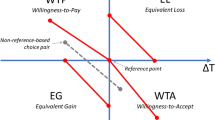Abstract
Based upon a long-term historical data set of US passenger travel, a model is estimated to project aggregate transportation trends through 2100. One of the two model components projects total mobility (passenger-km traveled) per capita based on per person GDP and the expected utility of travel mode choices (logsum). The second model component has the functional form of a logit model, which assigns the projected travel demand to competing transportation modes. An iterative procedure ensures the average amount of travel time per person to remain at a pre-specified level through modifying the estimated value of time. The outputs from this model can be used as a first-order estimate of a future benchmark against which the effectiveness of various transportation policy measures or the impact of autonomous behavioral change can be assessed.







Similar content being viewed by others
Notes
Another approach, which goes beyond the scope of this paper, assigns subnational projections of surface transportation demand to network-based supply models, thus significantly increasing complexity. The UK National Transport Model covers nine surface transport modes, eight trip purposes, and households located within nearly 2,500 zones (Department for Transport 2009). Partly owing to the increased complexity, the forecasting time horizon of this model is typically a few decades.
Arrival delay is defined as the difference between actual and scheduled arrival time as a share of scheduled flight time.
References
Airbus.: Global Market Forecast. Blagnac Cedex, (1996–2012)
Ben-Akiva, M.E., Lerman, S.R.: Discrete Choice Analysis. MIT Press, Cambridge (1985)
Ben-Akiva, M.E.: Modeling and Simulation for Future Urban Mobility. Working paper, ITS Lab, Department of Civil and Environmental Engineering, MIT, (2013)
Boeing.: Current Market Outlook. Commercial Airplanes, Seattle, (1997–2012)
Census Bureau.: Annual Projections of the Total Resident Population as of July 1: Middle, Lowest, Highest, and Zero International Migration Series, 1999–2100, Washington, DC, (2000). www.census.gov/population/projections/files/natproj/summary/np-t1.txt
Department for Transport.: National Transport Model: High Level Overview. London, (2009). webarchive.nationalarchives.gov.uk/20110202223628/http:/www.dft.gov.uk/pgr/economics/ntm/
Department of Transportation.: Airline On-Time Performance Data, (2012). www.transtats.bts.gov/Fields.asp?Table_ID=236
Department of Transportation.: National Household Travel Survey, Online Analysis Tool, (2013). http://nhts.ornl.gov
Energy Information Administration, EIA.: The National Energy Modeling System: an Overview. Office of Integrated Analysis and Forecasting, Department of Energy, Washington, DC, (2009)
Fearing, D., Barnhart, C.: Evaluating air traffic flow management in a collaborative decision-making environment. Transp. Res. Rec. 2206(2011), 10–18 (2011)
Fulton, L., Cazzola, P., Cuenot, F.: IEA mobility model (MoMo) and its use in the ETP 2008. Energy Policy 37, 3758–3768 (2009)
Goodwin, P.: Peak Travel, Peak Car and the Future of Mobility. Discussion Paper 2012, No.13. International Transport Forum, OECD (2012)
Gross, D., Shortle, J.F., Thompson, J.M., Harris, C.M.: Fundamentals of Queuing Theory, 4th edn. Wiley, Hoboken (2008)
International Civil Aviation Organization: ICAO (1990, 1995(1997), 2001, 2004. Outlook for Air Transport, Montreal (2007)
Joutz, F., Schäfer, A.: Income Distribution Effects on U.S. Air Travel Demand, Draft Paper, Precourt Energy Efficiency Center, Stanford University, (2014)
Kamargianni, M., Polydoropoulou, A.: Does Social Networking Substitute for or Stimulate Teenagers’ Travel? Findings from a Latent Class Model. 3rd International Choice Modeling Conference (ICMC), (2013) 3–5 July, 2013, Sydney, Australia. www.icmconference.org.uk/index.php/icmc/ICMC2013/paper/viewFile/761/353
Marchetti, C.: Anthropological invariants in travel behavior. Technol. Forecast. Soc. Chang. 47, 75–88 (1994)
Millard-Ball, A., Schipper, L.: Are we reaching peak travel? Trends in passenger transport in eight industrialized countries. Transp. Rev. 31, 357–378 (2010)
Mokhtarian, P.L., Chen, C.: TTB or not TTB, that is the question: a review and analysis of the empirical literature on travel time (and money) budgets. Transp. Res. Part A 38(9–10), 643–675 (2004)
Schäfer, A.: Evolution of Transportation Demand, Technological Change, and Energy Use in the US Transportation Sector since 1900. Draft Paper, Precourt Energy Efficiency Center, Stanford University, (2013)
Schäfer, A., Heywood, J.B., Jacoby, H.D., Waitz, I.A.: Transportation in a Climate-Constrained World. MIT Press, Cambridge (2009)
Schäfer, A., Victor, D.G.: The future mobility of the world population. Transp. Res. Part A 34(3), 171–205 (2000)
Small, K.A., Verhoef, E.T.: The Economics of Urban Transportation. Routledge, London and New York (2007)
Zahavi, Y.: The UMOT-Urban Interactions. DOT-RSPA-DPB 10/7. Department of Transportation, Washington, DC, (1981)
Zmud, J., Ecola, L., Phleps, P., Feige, I.: The Future of Mobility—Scenarios for the United States in 2030. RAND Corporation, Santa Monica (2013)
Acknowledgments
The author is indebted to Moshe Ben-Akiva and Frederik Joutz for invaluable econometric advice and thankful to Jim Sweeney for stimulating discussions. Tony Evans helped interpreting air travel delay data. Three unknown referees provided constructive comments, which helped improving the quality of the paper. Any misconceptions and errors remain the author’s sole responsibility. The funding provided by Stanford University’s Precourt Energy Efficiency Center that enabled this work is gratefully acknowledged.
Author information
Authors and Affiliations
Corresponding author
Electronic supplementary material
Below is the link to the electronic supplementary material.
Rights and permissions
About this article
Cite this article
Schäfer, A.W. Long-term trends in domestic US passenger travel: the past 110 years and the next 90. Transportation 44, 293–310 (2017). https://doi.org/10.1007/s11116-015-9638-6
Published:
Issue Date:
DOI: https://doi.org/10.1007/s11116-015-9638-6




